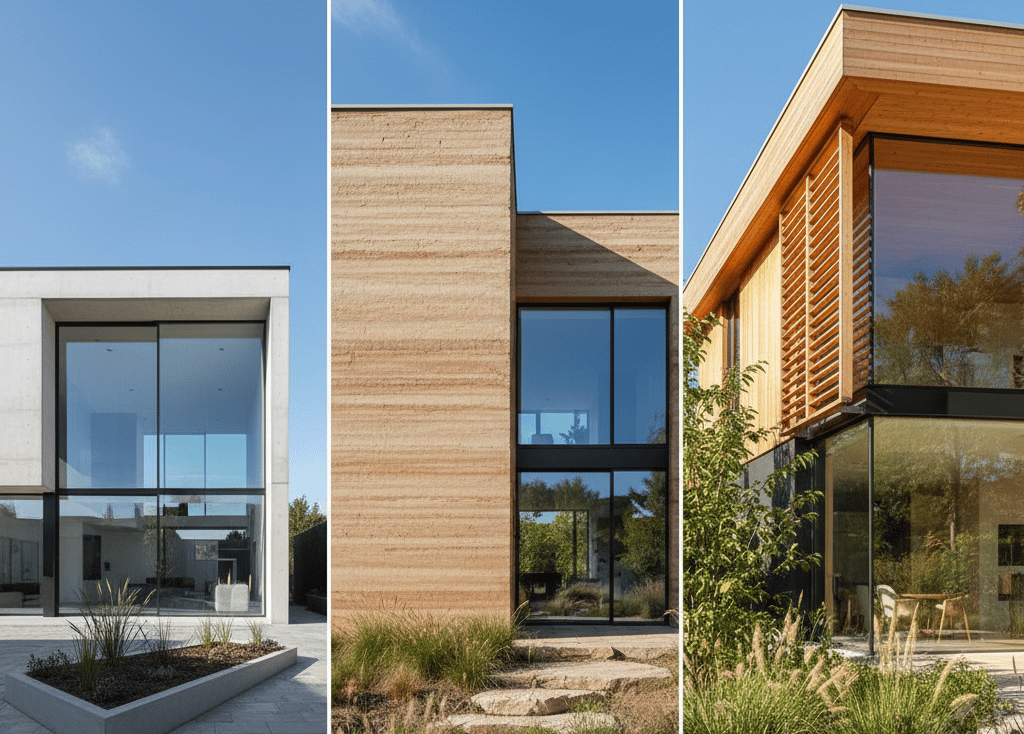Quality and technology IN CONSTRUCTION
delivered with STRAIGHT communication
Why Are Wood, Adobe, and Rammed Earth Returning? – The Role of Reimagined Natural Building Materials
Natural materials like timber, adobe, and rammed earth are making a comeback as low-carbon, healthy, and locally sourced alternatives to concrete and steel. While successful global examples prove their potential, real sustainability depends on strict engineering, regulation, and maintenance—not marketing slogans.
CONSTRUCTIONTRENDPROJECTMANAGEMENTFUTURESUSTAINABILITY
Dr. Toldy Gábor - Toldy Construct
10/7/20254 min read


Why Are Wood, Adobe, and Rammed Earth Returning? – The Role of Reimagined Natural Building Materials
Introduction: the “new” naturalness
Over the past hundred years, the construction industry has been built on reinforced concrete and steel—these materials gave modern cities their character. By now, however, they have also become some of the largest sources of humanity’s carbon footprint. Cement production accounts for roughly 8% of global CO₂ emissions, while the steel industry adds another 7% (IEA, Global Cement Report 2024).
It’s no surprise that attention is turning back to natural materials: timber, adobe, and rammed earth have suddenly gained new meaning. They are no longer the technologies of the past—they are potential tools for the future.
But before we idealize them, it’s worth looking at what actually works—and what is merely good-sounding marketing.
1. The advantages of natural materials—where is the line?
Carbon storage and low emissions
Mass timber (CLT—cross-laminated timber) structures can store up to 800 kg of CO₂ per cubic meter over their service life (World Green Building Council, 2023). That is a dramatic contrast to cement, which on average emits 0.9 tons of CO₂ per ton during manufacturing.Local material use
Adobe and rammed earth walls have the distinct advantage that the building site’s soil itself can be the raw material. Transport is practically zero, and the local character is preserved. According to Rammed Earth Construction (Cambridge University Press, 2022), locally made earth walls have 30–40% lower energy demand than fired brick.Thermal and comfort benefits
These materials have high thermal mass—they heat up slowly in summer and retain heat in winter. In the CERES Earth Building Project (Melbourne, 2021), adobe houses showed indoor temperatures on average 4–5 °C more stable than ambient fluctuations.Healthier interiors with less chemical burden
Adobe and untreated timber do not emit volatile organic compounds (VOCs), improving indoor air quality. ETH Zurich (Indoor Air Quality and Material Ecology, 2023) found that adobe and timber surfaces contain 50% fewer VOCs than modern polymer coatings.
All this is promising—but only as long as execution is disciplined, maintenance is consistent, and material use doesn’t become self-serving. A poorly insulated adobe wall or improperly treated timber can quickly lose all its “green” advantages.
2. Foreign examples where it already works
Brock Commons Tallwood House – Vancouver, Canada
This 18-storey student residence is one of the first “high-rise timber” buildings. It uses CLT and glulam, supplemented by a steel core. The entire frame was erected in 57 days (University of British Columbia, Project Report 2020).
Lesson: the project could only proceed via a special permitting process, as Canada’s building code originally allowed timber structures up to six storeys.
Carbon12 – Portland, Oregon (USA)
An eight-storey mixed-use building developed by Kaiser Group. The structure is entirely CLT. After fire-safety testing, it became the first permitted timber tower in the United States (US Department of Agriculture, Mass Timber Demonstration Program, 2022).
Stockholm Wood City – Sweden
This emerging district will comprise 25 timber buildings over 250,000 m², with housing and offices. According to the developers, the district will have a 30% lower carbon footprint than a conventional urban scheme (Atrium Ljungberg Development Plan, 2024).
Brettstapel systems – Austria, Germany, Switzerland
The glue-free panels connected with hardwood dowels have been enjoying a renaissance since the 2000s. Holzbau Austria Journal reports these structures are 100% recyclable with a service life of up to 80 years.
Bamboo architecture – Asia and Latin America
Bamboo can grow as much as one meter per day, and its fibers show tensile strengths comparable to steel (University of Cambridge, Bamboo Structural Research Unit, 2021).
Shigeru Ban’s Bamboo Furniture House in China (2002) was built from LVL bamboo and was the first house to receive approval under Japanese timber-building standards using a bamboo structure.
These are not experimental pavilions but functioning, occupied buildings. What they share: technological discipline, lengthy preparation, and the fact that each was realized through compromises.
3. Critical warnings—what marketing leaves out
Greenwashing at every level
Calling something “timber” or “adobe” does not automatically make it sustainable. The European Environment Agency (2023) warns that “bio-based” construction products increasingly veer into greenwashing because whole-life impacts are not fully assessed.Regulatory hurdles
Most countries’ building regulations were written around steel and concrete. In the US, the National Fire Protection Association only permitted timber buildings above 12 storeys from 2021 onward. Until then, projects required case-by-case approvals.Service life and maintenance
Natural materials are beautiful—but sensitive. Protection against insects, fungi, mold, and moisture demands careful design and ongoing maintenance. The RIBA Journal (2023) reports that several new earth-build projects in the UK experienced waterproofing issues within five years, primarily due to inadequate eaves design.Material supply constraints
Large-scale timber construction requires industrial-scale, certified forestry. According to the FAO Forest Report (2024), global supply of timber suitable for CLT lags demand by 40% annually—a recipe for market distortions.
Conclusion
The renaissance of timber, adobe, and rammed earth is not a return to the past, but an attempt for architecture to respond to the climate crisis. These materials can reduce construction’s carbon footprint and create more humane environments.
But anyone who thinks this is the sole path forward is mistaken. Natural materials work when the underlying technology, regulation, and professional culture are renewed alongside them. The “back to nature” slogan is worth taking seriously only when it is driven not by marketing but by engineering logic.
In the next part: how to build with these materials at scale, safely, and economically—and which technologies separate the ecological dream from industrial reality.
Sources
International Energy Agency (IEA) – Global Cement Report, 2024
World Green Building Council – Timber Construction and Carbon Storage, 2023
Cambridge University Press – Rammed Earth Construction Review, 2022
CERES Earth Building Project – Melbourne, 2021
ETH Zurich – Indoor Air Quality and Material Ecology, 2023
University of British Columbia – Brock Commons Project Report, 2020
US Department of Agriculture – Mass Timber Demonstration Program, 2022
Atrium Ljungberg Development Plan – Stockholm Wood City Overview, 2024
Holzbau Austria Journal – Brettstapel Systems Review, 2023
University of Cambridge – Bamboo Structural Research Unit Report, 2021
European Environment Agency – Green Claims in the Construction Sector, 2023
National Fire Protection Association – Tall Wood Building Standards Update, 2021
RIBA Journal – Challenges in Modern Earth Construction, 2023
FAO – Global Forest Report, 2024
Construction
With over 20 years of experience in general contracting, our company specializes in the flawless execution of unique, bespoke buildings. Our innovative methods and mindset make us stand out in the market.
Our services
Contacts
company@toldyconsult.hu
+36 30 289 2383
© 2024. All rights reserved.
Our WEBPAGES
www.toldyconsult.hu
